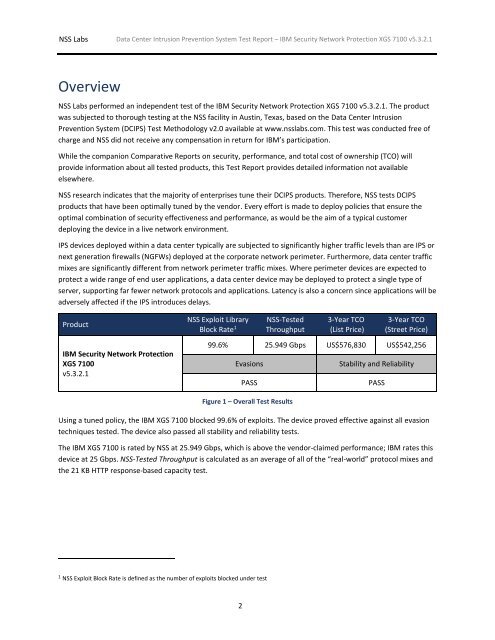NSS-Labs-Data-Center-IPS-Test-Report
You also want an ePaper? Increase the reach of your titles
YUMPU automatically turns print PDFs into web optimized ePapers that Google loves.
<strong>NSS</strong> <strong>Labs</strong><br />
<strong>Data</strong> <strong>Center</strong> Intrusion Prevention System <strong>Test</strong> <strong>Report</strong> – IBM Security Network Protection XGS 7100 v5.3.2.1<br />
Overview<br />
<strong>NSS</strong> <strong>Labs</strong> performed an independent test of the IBM Security Network Protection XGS 7100 v5.3.2.1. The product<br />
was subjected to thorough testing at the <strong>NSS</strong> facility in Austin, Texas, based on the <strong>Data</strong> <strong>Center</strong> Intrusion<br />
Prevention System (DC<strong>IPS</strong>) <strong>Test</strong> Methodology v2.0 available at www.nsslabs.com. This test was conducted free of<br />
charge and <strong>NSS</strong> did not receive any compensation in return for IBM’s participation.<br />
While the companion Comparative <strong>Report</strong>s on security, performance, and total cost of ownership (TCO) will<br />
provide information about all tested products, this <strong>Test</strong> <strong>Report</strong> provides detailed information not available<br />
elsewhere.<br />
<strong>NSS</strong> research indicates that the majority of enterprises tune their DC<strong>IPS</strong> products. Therefore, <strong>NSS</strong> tests DC<strong>IPS</strong><br />
products that have been optimally tuned by the vendor. Every effort is made to deploy policies that ensure the<br />
optimal combination of security effectiveness and performance, as would be the aim of a typical customer<br />
deploying the device in a live network environment.<br />
<strong>IPS</strong> devices deployed within a data center typically are subjected to significantly higher traffic levels than are <strong>IPS</strong> or<br />
next generation firewalls (NGFWs) deployed at the corporate network perimeter. Furthermore, data center traffic<br />
mixes are significantly different from network perimeter traffic mixes. Where perimeter devices are expected to<br />
protect a wide range of end user applications, a data center device may be deployed to protect a single type of<br />
server, supporting far fewer network protocols and applications. Latency is also a concern since applications will be<br />
adversely affected if the <strong>IPS</strong> introduces delays.<br />
Product<br />
IBM Security Network Protection<br />
XGS 7100<br />
v5.3.2.1<br />
<strong>NSS</strong> Exploit Library<br />
Block Rate 1<br />
<strong>NSS</strong>-<strong>Test</strong>ed<br />
Throughput<br />
3-Year TCO<br />
(List Price)<br />
3-Year TCO<br />
(Street Price)<br />
99.6% 25.949 Gbps US$576,830 US$542,256<br />
Evasions<br />
PASS<br />
Stability and Reliability<br />
PASS<br />
Figure 1 – Overall <strong>Test</strong> Results<br />
Using a tuned policy, the IBM XGS 7100 blocked 99.6% of exploits. The device proved effective against all evasion<br />
techniques tested. The device also passed all stability and reliability tests.<br />
The IBM XGS 7100 is rated by <strong>NSS</strong> at 25.949 Gbps, which is above the vendor-claimed performance; IBM rates this<br />
device at 25 Gbps. <strong>NSS</strong>-<strong>Test</strong>ed Throughput is calculated as an average of all of the “real-world” protocol mixes and<br />
the 21 KB HTTP response-based capacity test.<br />
1<br />
<strong>NSS</strong> Exploit Block Rate is defined as the number of exploits blocked under test<br />
2


